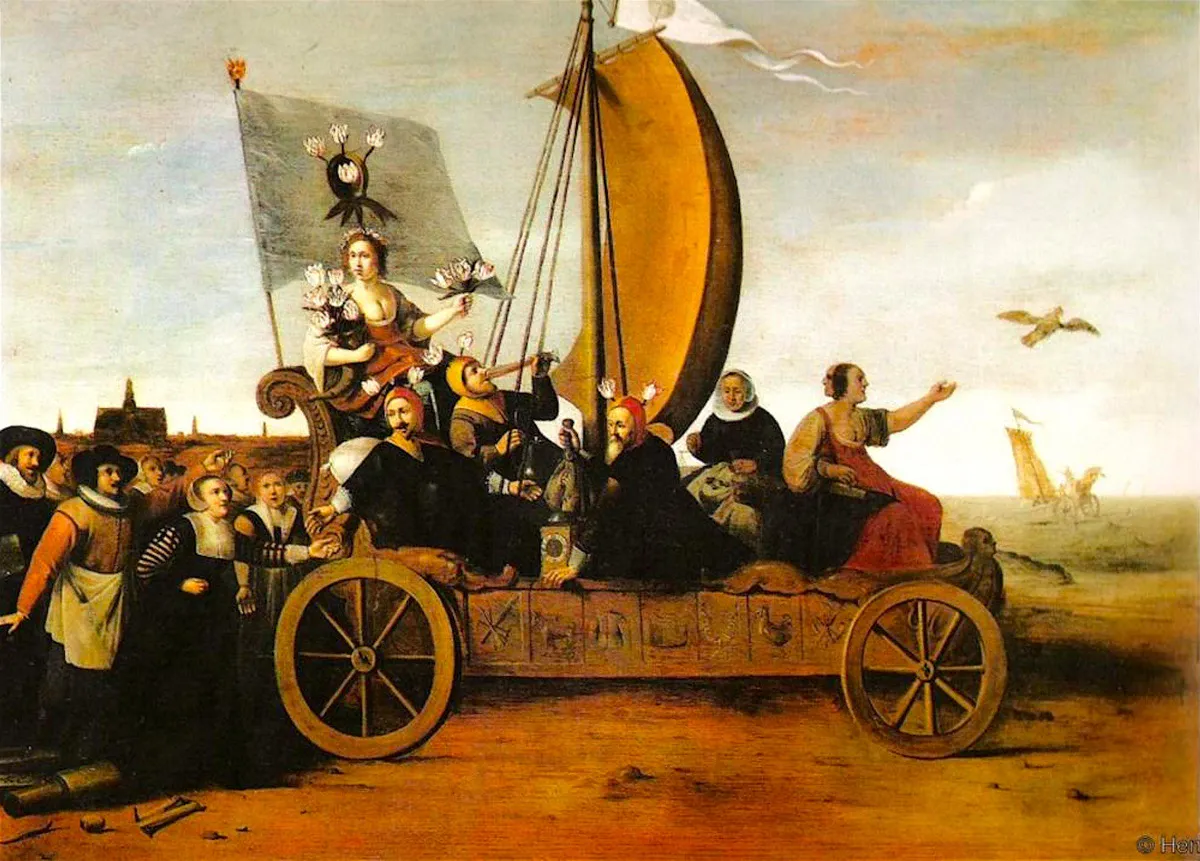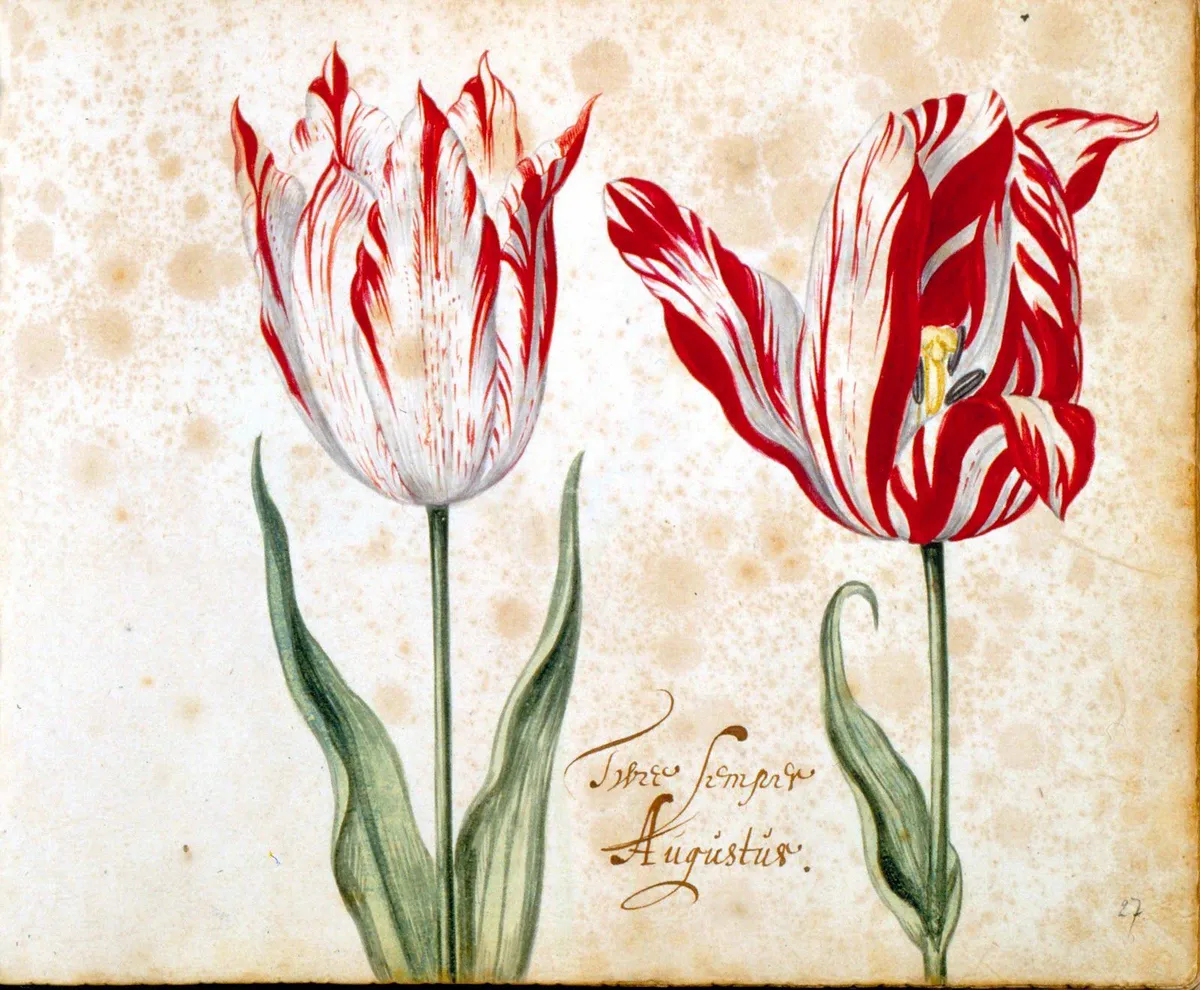Welcome to the mad, mad world of Tulip Mania fun facts! Let’s time-travel to 17th century Holland, where folks had a slight obsession with tulips. Alright, maybe not just slight – think of it as that friend of yours who can’t stop posting about their latest avocado toast obsession, but, you know, 400 years ago.
In the brisk years between 1636 and 1637, the people of Holland got hit by a very particular fever – and no, it wasn’t windmill madness! The nation was under the grip of Tulip Mania, an economic bubble where the prices of tulip bulbs soared so ridiculously high that some of these flower bulbs were worth more than a fancy canal house in Amsterdam. Talk about some petal power!
Now, how could something as simple as tulips cause such frenzy? It’s a blend of human psychology, the appeal of rarity, and, of course, a dose of that good ol’ social peer pressure (because if Johannes has a fancy tulip in his yard, you better believe Maria wants one too!).
As much as we chuckle at these interesting facts about a full-blown floral financial fracas, it’s also a serious lesson in how markets can inflate, and oh boy, how they can pop! But fear not, we’re here to keep things light and playful. So, brace yourself for a bouquet of hilarity as we dive deep into the quirkiest, wackiest, and downright absurd moments of the world’s first-ever economic bubble. Ready to bloom with laughter? Let’s go!
Fast Facts: Tulip Mania
- Origin of Popularity: Tulips were introduced to Europe in the mid-16th century from the Ottoman Empire, but it was in Holland where their popularity truly blossomed.
- Peak Prices: During the peak of Tulip Mania in 1636-1637, some tulip bulbs fetched higher prices than houses in Amsterdam’s prime locations.
- “Semper Augustus” Fever: The “Semper Augustus” was the most coveted and expensive tulip, with prices that could match the cost of a grand canal house in Amsterdam.
- Nature’s Art: The vibrant and unique patterns on some tulips, especially the flame-like streaks, were caused by the tulip breaking virus, also known as the mosaic virus.
- Trading Venues: Tulip trading wasn’t done on traditional stock exchanges. Instead, deals were often struck in taverns and pubs in a system called “college.”
- Rapid Collapse: The bubble’s end came swiftly in February 1637, when prices began a freefall from which they’d never recover.
- Economic Impact: Despite the dramatic crash in tulip prices, the overall Dutch economy remained stable, though many individual traders and speculators faced ruin.
- Legal Entanglements: The fallout from the burst bubble led to a myriad of legal challenges, with many contracts declared null and void by the Dutch government.
- Future Bubbles: Tulip Mania is often cited as the first major financial bubble, but it set the stage for many more speculative bubbles in history, including the South Sea Bubble and the Dotcom Bubble.
- Modern Comparisons: Many financial experts and historians draw parallels between Tulip Mania and modern speculative events, like the cryptocurrency boom.
Alright, fasten your seatbelts and put on your best clog-dancing shoes, because we’re diving deeper into the flower pot! Having brushed up on the essential deets, let’s now venture into the quirky, the whimsical, and the downright amusing alleys of history. Here comes a bloomin’ bouquet of 15 fun facts about Tulip Mania that’ll tickle your petals and perhaps make you view your garden in a whole new light! 🌷🎉

Image source: robscholtemuseum.nl
1. Special Delivery: The First Futures Market
Hold onto your tulip crowns, because we’re diving deep into the annals of commerce! While Tulip Mania might be remembered for its bubble, it also witnessed the birth of what we now know as futures contracts. That’s right, way before Wall Street had its high-speed trades, 17th-century Holland was pioneering early financial innovation.
Traders, ever eager to cash in on the tulip craze, would enter contracts to buy bulbs at the end of the season. These contracts could then be bought and sold, effectively becoming their own commodities! Essentially, folks were trading the promise of tulips. Modern comparisons? Think of it like pre-ordering the latest iPhone, then selling your spot in line for a profit before it’s even released!
2. Some Serious Bubbly Drama
Roll out the red carpet, because in 1636, tulips were the celebrities of the plant world in Holland. Here’s a jaw-dropping fact: these humble bulbs could fetch prices higher than what most folks earned in a year!
Can you imagine trading a gorgeous canal house for, let’s say, a single petal-y diva? It sounds absurd, but it was the reality. It’s like swapping a penthouse for a pet parakeet today. The bubble created such a real estate ruckus that it’s a wonder there wasn’t a reality show titled “Keeping Up with the Tulips.”
3. Tulip Names with a Flair
Tulips during the mania weren’t just known for their exorbitant prices but also their flamboyant names. Much like how we have fancy titles for paint colors today (Sunset Orange, anyone?), 17th-century Holland had a knack for naming tulips in a manner that reflected their elegance and allure.
Many tulips were named to evoke luxury and rarity, like ‘Admiral van der Eijk’ or ‘Semper Augustus’. And while we might find these names amusing now, back then, owning a tulip with such a regal name was a serious bragging right. Think of it as the vintage version of having the latest iPhone or wearing designer brands – only this time, it’s a flower stealing the spotlight!
4. No Instant Messaging, Only Instant Trading
Imagine a world without smartphones, the internet, or even fax machines (if you remember what those are). In 1637, when tulip trading was at its peak, deals were sealed not over encrypted chats, but face-to-face in bustling taverns. Traders would huddle, beer in one hand, tulip bulb in the other, bartering like there’s no tomorrow.
“Two pints for that ‘Majestic Sunset’ tulip?” It’s a wonder they didn’t mix them up after a few too many drinks. These were the true OG chat rooms, filled with haggling, hustling, and perhaps a touch too much ale.
5. The “Semper Augustus” Hype
Back in the 1600s, there wasn’t an Instagram or Twitter to trend the hottest sensations. Yet, even without hashtags, the Semper Augustus became the floral sensation everyone in Holland was tweeting – err, talking about. This tulip was the belle of the ball, the Beyoncé of bulbs, if you will.
If tulips were stocks, Semper Augustus was like the Apple share everyone wished they had invested in. It had a price tag that would make anyone’s wooden shoes drop – equivalent to a luxurious house! If there were influencers back then, you can bet they’d be taking selfies with this posh petal.

Image source: atlasobscura.com
6. Flower Frenzy Vs. Cheese Craze
We’ve all heard of Tulip Mania, but did you know the Dutch also had a big thing for cheese (and still do)? At the peak of the tulip craze, some tulip bulbs were so pricey that they could net you a wheel of the finest Gouda in town.
Just picture this: traders huddled in a bustling market, arguing whether a flower bulb is worth the equivalent of a year’s supply of cheesy delight. “Will it be tulips on your table or a cheese feast?” Decisions, decisions! And you thought choosing between two Netflix shows was tough.
7. Guess Who’s Coming to Dinner?
During the height of Tulip Mania, a bulb wasn’t just a pretty thing to plant in your garden; it was a status symbol! If you had a rare tulip bulb, you were “the bee’s knees.” But here’s a fun twist: people didn’t just flaunt them in gardens or trade them – they displayed these bulbs at dinner parties. Yep, you heard it right!
Imagine having guests over, and instead of showing off your new sound system or the latest piece of tech, you’d have a tulip bulb sitting at the center of the dining table. “Behold! My precious Semper Augustus bulb!” one might say. To which the guests might respond, “Incredible! Much better than the Admiral van der Eijck we saw at Jan’s place last week!” Oh, the conversations and the envy it must have sparked! Forget wine or cheese tastings; this was bulb boasting at its best.
8. The OG Cryptocurrency?
Think Bitcoin is a modern mania? Holland of 1636-1637 says, “Hold my tulip.” Before digital wallets and blockchain, the Dutch were digging deep into their gardens for their own version of gold – the tulip bulbs.
The parallels are uncanny: a rapid rise in value, intense speculation, and a crash (or should we say, “wilt”) that left many bewildered. But while Bitcoin might leave you with digital pride, the tulips at least left the Dutch with a pretty garden!
9. Legal Troubles Over Tulips
Ah, Holland in the 17th century: where flowers could cause legal frenzies! As Tulip Mania reached its pinnacle, the market was, let’s just say, not rosy. Contracts were more tangled than headphone cords in your pocket. The situation got so haywire that the Dutch law system had to jump in.
They started drafting legislation specifically to untangle the bulb blunders. Imagine needing a judge and jury because your Beanie Baby collection got out of hand. It’s basically the same thing. Only, instead of plush toys, they had perennials!
10. The “Mosaic Virus” – Nature’s Own Art Kit
Sometimes, imperfections can be beautiful! The most coveted tulips, the ones with swanky streaks and flamboyant flares, weren’t showing off designer genes. Nope, they were actually under the weather, thanks to the mosaic virus.
But, just like how we adore vintage filters and photo edits today, Holland of the 1636-1637 era thought these sickly tulips were the bee’s knees. A viral sensation, literally!

Image source: i1.wp.com
11. Tulips: The Forbidden Fruit
Remember sneaking candies as a kid? Now imagine doing that but with, well, flower bulbs. At the height of Tulip Mania, the value of these bulbs was such that some couldn’t resist the urge to pocket a few illicitly.
Think of it as the 17th-century version of the five-finger discount. While we chuckle at the idea of garden heists today, back then, it was serious petal pilferage!
12. Burger for a Bulb
Holland’s Tulip Mania brought some zany exchanges to the fore. Imagine walking up to a food stall, slapping down a tulip bulb, and walking away munching on a juicy burger. It’s akin to trading your latest tech gadget for a slice of pizza today.
While our modern sensibilities might scoff at such an idea, back in the bubbly days of 1636-1637, such trades were the norm. So, next time you’re at a fast-food joint, ponder if your meal is bulb-worthy!
13. Flower Fortune Tellers
The 1636-1637 tulip craze wasn’t just about buying and selling; it was also about predicting! In Holland, certain folks claimed they had the magic touch, not with crystal balls but with tulip bulbs. “I foresee a rise in the Admiral Liefken variety next month,” one might have proclaimed, while stroking their chin knowingly.
These so-called flower fortune tellers were the financial astrologers of their day. Maybe they read petal arrangements or bulb vibes, who knows? Some probably made spot-on predictions, while others… maybe should’ve stuck to reading tea leaves.
14. Overnight Millionaires… and Paupers
The tulip trade in Holland was a wild rollercoaster! Some rode it to the top, sipping champagne (or, more likely, ale) on their newfound riches. Others? Well, their experience was less “yay” and more “nay.”
It’s amusing to think of Jan the farmer becoming Jan the mogul, while Pieter the merchant might have been ruing the day he traded his boat for bulbs. Guess he didn’t sea that coming!
15. The Floral Bubble Burst
As with all good things (and financial bubbles), Tulip Mania had to come to an end. And what a finale it was! By 1637, the tulip market took a nosedive. It’s one thing to bet your money on stocks or real estate, but flowers?
The same folks who were flaunting their fancy fringed tulips were now probably trying to barter them for bread. From floating on air to a flower fail, many were left wondering if they’d been hit by a petal-powered prank.

FAQ
What happened during tulip mania?
During the Tulip Mania, which took place in the early 17th century, particularly between 1636-1637, the prices of tulip bulbs in Holland skyrocketed to unbelievable heights. Tulips became such a prized commodity that they were being traded on Dutch stock exchanges, with some bulbs fetching prices higher than the cost of luxurious houses! However, as with many speculative bubbles, the prices dramatically collapsed, leaving many traders in financial ruin.
What was the main cause of tulip mania?
The main cause of Tulip Mania was a combination of supply-demand imbalances and intense speculative trading. Initially, tulips were a novelty, imported into Holland from Turkey. Their unique and varied patterns (some of which resulted from a virus) made them highly sought after. As their popularity surged, speculators entered the market, buying bulbs with the hope of reselling them at higher prices. This speculation, combined with a lack of regulation, drove prices to unsustainable levels.
How did tulip mania impact the economy?
When the bubble burst in 1637, many people who had invested their life savings in tulip trading were left bankrupt. While the overall Dutch economy remained robust due to its diverse commercial activities and overseas colonies, the collapse impacted individual traders significantly. Some traders found themselves in massive debt, while others even faced legal challenges due to unfulfilled contracts.
What are the lessons learned from tulip mania?
The Tulip Mania is often cited as a cautionary tale about the dangers of speculative bubbles. The lessons learned include the importance of recognizing when asset prices are driven more by speculation than by intrinsic value. It also underscores the risks of herd behavior in financial markets, the dangers of trading on credit, and the need for market regulation to prevent unchecked speculation.
What was the most expensive tulip sold during tulip mania?
The most famous and coveted tulip during the Mania was the “Semper Augustus.” This stunning bloom was renowned for its striking crimson and white streaks. Reports from the period suggest that at the height of the bubble, a single “Semper Augustus” bulb could sell for the price of a grand canal house in Amsterdam, equivalent to thousands of florins! To put that in perspective, an artisan might have earned about 150 florins in a year. That’s one pricey petal party!





